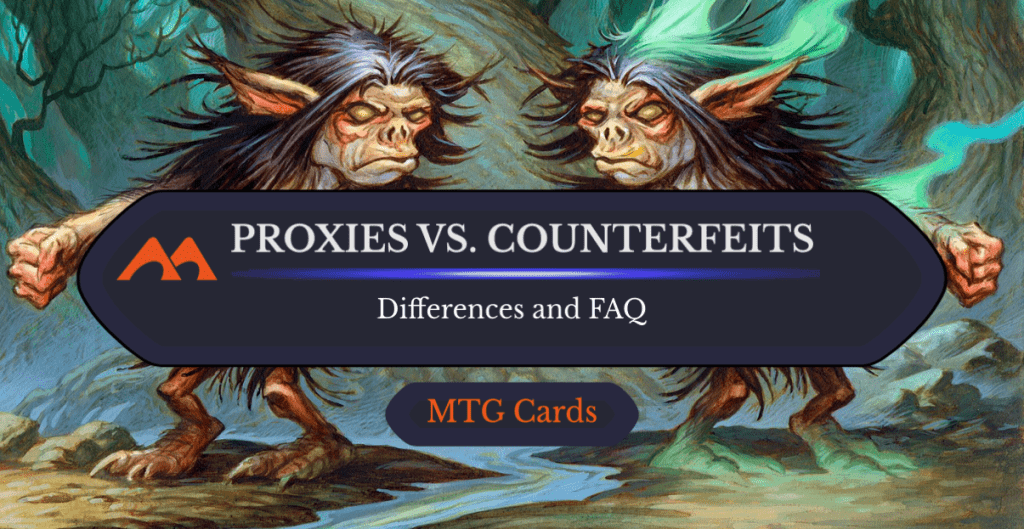
Spitting Image | Illustration by by Jim Nelson
It’s no secret that MTG can be an expensive game, depending on the kind of decks you want to build or formats you want to play. After all, we need cards that are printed exclusively by WotC, and we all know that some cards are more desirable or less printed than others.
Today, we’re going to see two parallel, unofficial ways to get access to cards. You can proxy a card and put it in your deck, and that’s totally accepted and sometimes even incentivized by the casual community. There's also counterfeiting or buying fake cards, which is totally illegal and you should never do it.
Let’s find out the differences between proxying cards and counterfeiting cards so you’ll know what should and shouldn’t be done.
What’s the Difference Between Proxies and Sealed?

Pirated Copy | Illustration by Daarken
A proxy card is an unofficial copy of an MTG card intended for use in casual settings, with no intention of being taken as an official product. It’s not printed by WotC’s exclusive card printers, and it’s not sold in sealed products. Proxies function as a copy of another product entirely.
Counterfeit cards are fake cards sold as though they’re the real deal. This is illegal, considering MTG cards are trademarked and a legal property of WotC. The worst problem with counterfeiting is that people acquire these fully expecting the real deal, and often lose hundreds of dollars on something that’s not worth a penny.
The main thing that differentiates proxies from counterfeits is that only the counterfeit attempts to be the real thing, while the proxy always looks like something else entirely.
Card Back
A good way to signal to everyone you’re playing with a proxy deck is to have an alternative card back for all the proxies in your deck, or at least a different card back than an original MTG card. In this case, you shouldn’t mix real cards and proxy cards without using sleeves, because proxies can be easily identified in other zones such as your library or your hand. Proxy sites like mtgproxy.com or printingproxies.com often ask you what card back you want, or even offer you the possibility of suggesting a card back. Here are some examples:
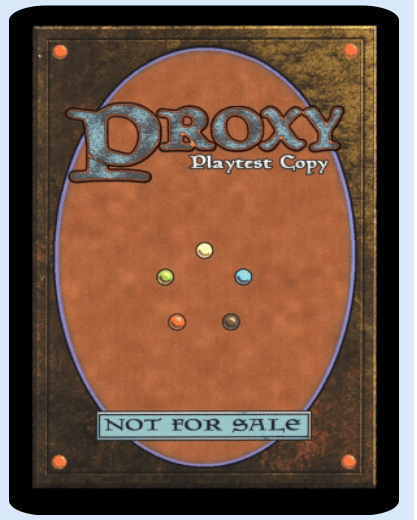
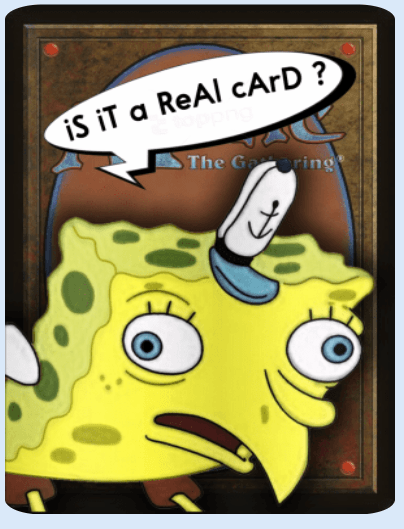

Card Face
Sometimes, proxies use new or alternative arts/card borders that don’t actually exist in Magic. These are a clear and surefire way to spot them.
While counterfeit cards aim to look as close as the real card as possible, proxies often have alternate art or card borders. That’s done to show everyone that you’re playing with proxies. In this case, the proxy card has to be very legible – especially the rules text, if any. In-game characteristics, like the power, toughness, or the color of the card should also be recognizable from a distance.
Here are some examples of proxies on their front face, with alternate art, frame, or rules text:
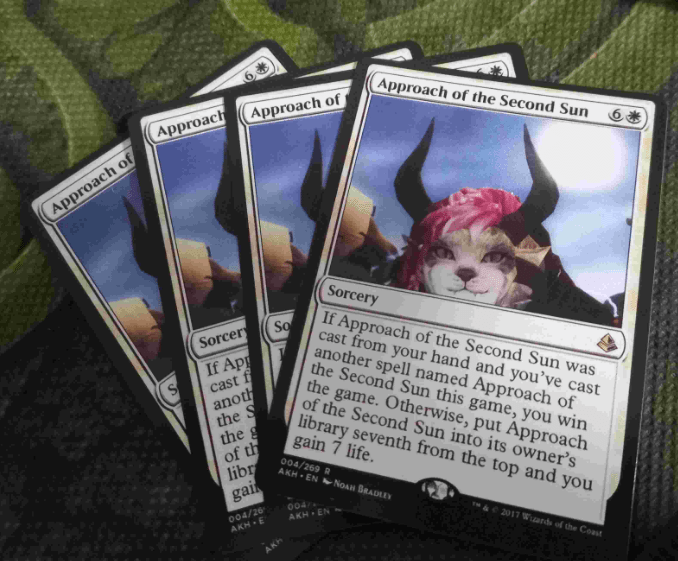
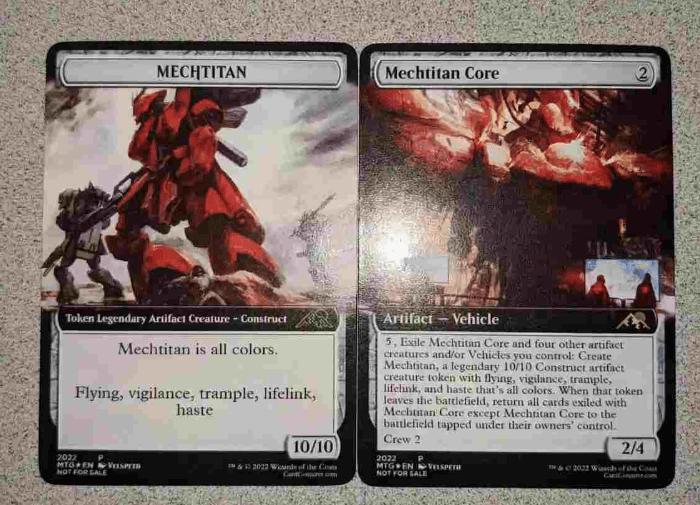
Usage
Counterfeits are cards that simulate legal and real cards, so people usually play counterfeit cards at the FNM level or at sanctioned tournaments. People can also print counterfeit cards and try to sell them online as if though they’re authentic.
On the other hand, proxies are substitutes for expensive cards you won’t risk putting into your deck, perhaps for a Cube or EDH deck you want to build, or for aesthetic reasons. Some Vintage and Legacy competitive scenes fully allow players to play with proxies because they understand that the meta evolves in a more meaningful way, or that there’s going to be more competition if players can proxy fetch lands, original dual lands, or even power 9 pieces. The thing is, when you’re using proxies, everyone can or should be able to recognize them from a distance. Because of this, proxies often have different foiling processes or entirely different card arts or frames.
Legality
Making or printing proxies isn't illegal. You can even sell proxies you’ve printed to another person – and in this case the person is fully aware that they’re buying a proxy card. For example, let’s say I print a proxy of an expensive card, The Tabernacle at Pendrell Vale. I can legally sell the proxied Tabernacle to another MTG player for, let’s say, $5.
With counterfeiting, however, I’ll try to print an almost exact copy of a real Tabernacle, and try to sell it for $1000 to another MTG player. This is a totally illegal scam. The best way to identify a true card from a fake, counterfeit card is to amplify the image several times and observe the ink patterns on the card. Many unadvised players won’t have the resources available or even the knowledge to do this, and they’ll think that they’re getting the best deal ever.
To quote a professional proxy seller: “I sell proxies. It's 100% distinguishable. You won't be able to sell them/pass them as real. The back is custom.”
Wrap Up

Identity Thief | Illustration by Dan Scott
I hope I’ve shone a light on a controversial topic. Proxies and counterfeiting are two different things entirely. They’re different forms of an MTG card that aren’t legit, so people try to put them in the same basket. You should proxy cards that you don’t have, cards that you own that are very expensive and you’re trying to preserve, and ones that you intend for casual play or events that allows proxies. People often proxy decks to test before acquiring the individual cards, or to test spoiled cards before they’re available. At sites like printingproxies.com or mtgproxy.com, you can buy a proxy card for prices around $1-2 each, and it gets cheaper if you buy them in bulk. You can construct entire Cubes or EDH decks for less than $200.
What's your personal stance on proxies? Pro or against? Let me know in the comments section below or on our Draftsim Twitter account.
Thanks for reading guys, and see you later.
Follow Draftsim for awesome articles and set updates:

Add Comment